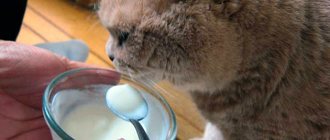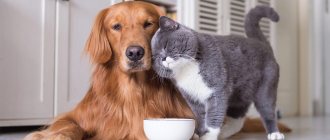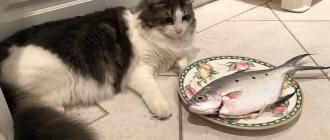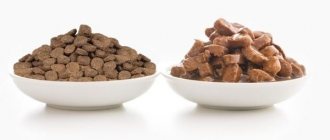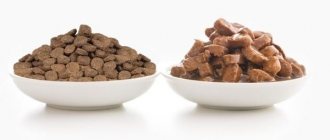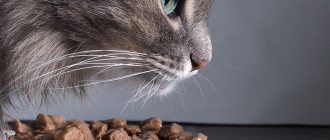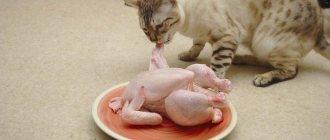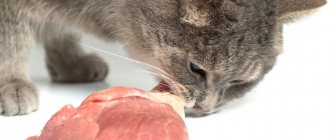A balanced diet is the foundation of a pet’s health and longevity. It is known that cats are carnivores and their natural food is meat. In urban living conditions, owners are not able to provide the cat with the opportunity to hunt, so the purrs have to eat store-bought food. To save money and ease of preparation, many owners take meat and poultry by-products as the basis for their diet. Recently, debates have flared up on the topic: is it possible to feed a cat chicken liver? Let's figure it out.
About the beneficial properties of the liver
The benefits of liver as a product for humans are obvious. Is it possible to give this food to a cat? It would be useful to know the opinion of veterinarians. And they unanimously claim that liver for cats is necessary as an additive to the diet. But you cannot use this offal as a basis, replacing meat with it, despite the fact that the liver is very useful.
Beneficial properties of beef liver:
- it contains water-soluble B vitamins, which are responsible for healthy elastic skin and elastic, bright, shiny coat of the cat, its energy and good functioning of the gastrointestinal tract;
- The offal is rich in retinol (vitamin A). It increases bone density and strength, visual acuity of cats, and also strengthens the animal’s immune system;
- the liver contains tocopherol (vitamin E) and ascorbic acid (vitamin C) - necessary substances to increase the cat’s immunity and the body’s absorption of important microelements.
Meat by-product is high in vitamins:
- D – plays an important role in the body, necessary for better absorption of calcium;
- E – for good functioning of the circulatory system, proper production of hormones, improved cellular respiration and healthy reproductive function;
- K – necessary to improve blood clotting.
The liver contains valuable microelements - iron, phosphorus, magnesium, sodium, zinc and essential amino acids. An important beneficial property is the high nutritional value of the offal - useful animal protein is 25%, fats - only 5%, the composition contains a large number of essential amino acids and fatty acids. However, despite the obvious benefits of this product, feeding cats with liver can harm the animal.
Is it necessary to add vitamins, microelements and minerals to the diet?
When feeding ready-made food for cats with liver diseases, there is no need to give the animal additional vitamin and mineral complexes, since they are included in biscuits or canned food. With a “natural” diet, it will not be possible to get the required amount of nutrients, especially if the pet is mischievous and does not want to eat vegetables and grass (for example, sprouted oats). In this case, you should ask your veterinarian to select a suitable preparation with vitamins, micro- and macroelements.
It is better not to buy vitamin and mineral complexes yourself without consulting a doctor, as you may choose the wrong product (for a cat with an unhealthy liver, both a deficiency and an excess of micro- and macroelements is harmful)
What is harmful to the liver?
There are several reasons why it is not recommended to give your pet raw liver:
- any liver is a filtration organ containing toxins; in addition, it is often parasitized by helminths or their eggs and larvae. Therefore, raw liver in an animal’s diet is a threat of helminthiasis;
- liver as an offal is high in calories. Frequent feeding of it can lead to rapid weight gain and obesity;
- vitamins found in the offal tend to accumulate in the cat’s body, which can cause hypervitaminosis and, as a result, diarrhea, vomiting, hair loss and muscle pain.
Raw liver takes a very long time and is difficult to process in the cat’s body. This is a serious burden on her gastrointestinal tract and digestive organs. Cats can be especially affected: they are more likely than cats to experience constipation or diarrhea. Therefore, veterinarians and cat breeders are extremely careful when feeding animals raw liver.
What are the symptoms of the disease?
In the acute phase of the disease, the pet experiences:
- lethargy;
- jaundice;
- fever;
- the animal refuses to eat, loses weight;
- attacks of thirst are observed;
- bloating;
- vomiting, diarrhea or, conversely, difficulty with bowel movements;
- enlarged lymph nodes.
Liver failure most often occurs in older animals who have crossed the 9-year mark. There are several reasons that provoke the occurrence of the disease:
- These are cancerous tumors of the liver and other organs that metastasize to it.
- Diseases of the endocrine system, animal poisoning with toxic substances from eating mice, drug overdose.
- The animal could have fallen from a considerable height or been hit by a car, infectious diseases, heart problems.
https://www.youtube.com/watch?v=https:accounts.google.comServiceLogin
Symptoms that determine the occurrence of the disease:
- vomit;
- stools are light, liquid, with blood;
- the cat refuses food and water, is lethargic;
- yellowness of the mucous membranes of the mouth and eyes appears;
- jumps in body temperature;
- itching;
- there is a noticeable increase or decrease in the weight of the animal.
Basic feeding rules
How to properly introduce beneficial substances from the liver into a cat’s diet without harming the animal? Veterinarians advise adhering to the following recommendations when introducing offal into a cat’s diet:
- give boiled liver, keeping it in boiling water for 5-10 minutes, since during prolonged cooking some of the vitamins are lost;
- feed no more than 1-2 times a week;
- a serving of liver should not account for more than 10% of a cat’s daily diet;
- buy and give your pet only a high-quality product.
You should also keep in mind that not all types of liver are equally beneficial for your cat. There are no problems with purchasing dietary medicinal offal now. You can choose chicken, pork, or beef. But of all types of liver, beef is preferable. It contains more protein that synthesizes iron proteins, which improve the composition and quality of the pet’s blood. Beef liver is high in taurine, an essential amino acid that keeps your cat healthy and strong. The norm of beef, according to veterinarians, in a cat’s diet should be no more than 5%
Chicken liver is less useful; it contains less healthy proteins, but more fat. Pork liver is inferior in health to chicken and beef. Pork liver contains more toxins and fats, which increase the level of “bad” cholesterol in the animal’s blood. Therefore, many veterinarians do not recommend introducing pork liver into the diet of cats. In addition, it has a bitter taste, which is why animals themselves refuse such food.
What ready-made food can I use?
For cats with liver diseases, there are special medicinal foods - their names contain the terms Hepatic or Liver Care. They help slow down the progression of the disease, reduce the load on the organ, and help maintain and restore the functioning of the entire body.
There are also ready-made foods created for cats with liver disease.
What is included in medicinal feed for animals with liver diseases
Food for cats with liver pathologies can be either dry or wet (that is, in the form of pate or meat pieces in jelly). The main condition is that the composition should not contain any preservatives, thickeners, or flavor enhancers. They are always added to economy-class feeds, which are not suitable for sick animals. The Hepatic or Liver Care series are only available in the premium feed category.
The presence of starch and protein hydrolysate in the feed is beneficial in case of chronic liver failure
The nutritional value of medicinal feed should be approximately as follows:
- protein - 15–28%;
- fat - no more than 22%;
- fiber - at least 3%.
Corn gluten, dehydrated poultry or fish, beet pulp, and powdered eggs can be used as a source of protein. Vitamins and minerals are an essential component of medicinal feed. The composition should contain vitamins D3, A, E, B, PP, C, iron, zinc, iodine, selenium, sodium, taurine. Copper should be no more than 4.2 mg (excessive consumption of this mineral puts too much stress on the liver).
An increased content of omega-3 polyunsaturated fatty acids in the food helps improve the well-being of a cat weakened by illness.
Is it possible to use medicated food without consulting a specialist?
Before using medicated food, you should consult your veterinarian. You should make sure that the cat really has liver problems. The symptoms of different diseases can be similar, and different diagnoses require their own diet. Medicinal foods marked Hepatic or Liver Care are only suitable for animals with liver pathologies - they are not used for other diseases or for prevention.
How long can you feed your pet medicated food?
The duration of diet therapy depends on the type of pathology. After an exacerbation, it is recommended to give medicinal food to cats with liver pathologies for at least 6 months. With chronic liver disease, there is a need for medicated food throughout the cat’s life (but the decision about this must be made by a veterinarian).
Is it possible to mix special food with regular food?
It is not recommended to mix regular food with medicinal food, since when mixing it is almost impossible to accurately calculate the daily content of all the substances necessary for a sick cat. You can switch completely to non-medicinal products only with stable remission and only with the permission of a doctor. And even in this case, the selection of food must be carried out carefully, taking into account the quality and composition - this is due to the fact that the threat of exacerbations will persist all the time, the liver cannot fully recover.
How to choose the “right” liver
When choosing an offal for your pet, do not skimp; choose high-quality beef or chicken liver. By buying a low-quality, cheap product for an animal, you risk its health. Basic rules when buying liver in a store:
- Make sure that the purchased product is fresh. Therefore, it is not recommended to buy frozen liver - it is very difficult to check its quality and shelf life;
- pay attention to the color of the offal. A greenish tint to the liver indicates that bile has spread out of the gallbladder during slaughter and the product is spoiled. A bright orange or pale color of the liver indicates non-compliance with the temperature conditions for storage or transportation or repeated defrosting/freezing. The loose matte surface of the offal indicates improper storage or the expiration date of the product.
A high-quality liver is characterized by the following features:
- has a dense structure;
- the surface is smooth and shiny;
- The color of the product is rich brown-burgundy.
If a product has all of the above characteristics, feel free to introduce it into your pets’ diet.
Contraindications for feeding
Not all cats tolerate a particular food equally. When introducing liver into your pet's diet, pay attention to the animal's condition. If your cat begins to have problems with stool - constipation or diarrhea - limit or completely remove liver from the animal’s menu.
Liver is contraindicated in animals:
- having diseases of the digestive system and gastrointestinal tract;
- prone to allergies;
- obese or overweight;
- cats with pancreatic diseases.
Important!
Unprocessed liver has a laxative effect, while boiled liver, on the contrary, strengthens it. This must be taken into account when feeding animals with digestive problems.
Lungs - is it worth giving them to a cat?
One of the most useless beef by-products is lung. It is made of connective tissue and is difficult for cats to digest. In many animals, eating “airy” offal causes vomiting. Therefore, it is given in small quantities and in combination with meat or other organs.
Beef lung
It is quite possible to create a complete diet without using lungs, but if the cat likes their taste, they are fed in a volume of 5-15% of the diet. The peculiarity of this by-product is its low calorie content, which can be useful when preparing a diet for overweight animals.
If you cut the lung into small pieces and dry it in the oven, you will get an excellent delicacy. It is given to cats between main feedings.
